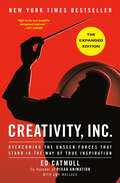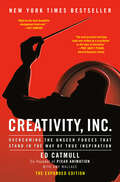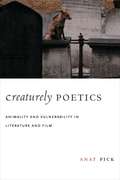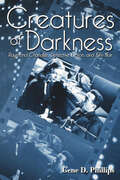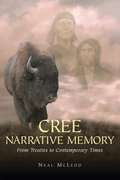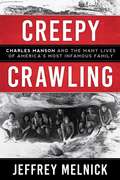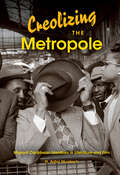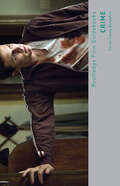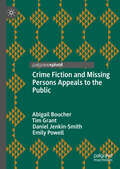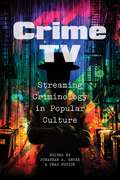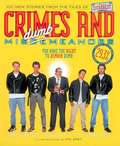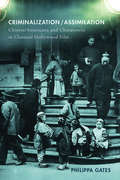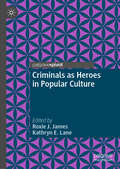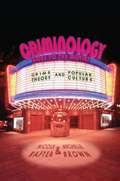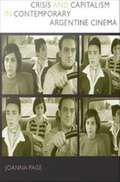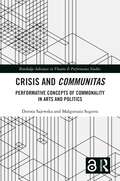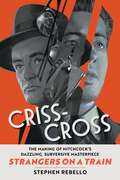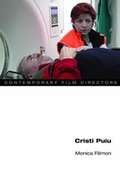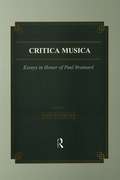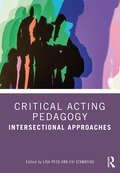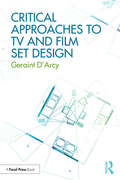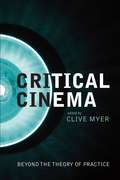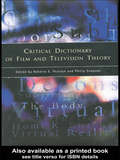- Table View
- List View
Creativity, Inc.: Overcoming the Unseen Forces That Stand in the Way of True Inspiration
by Amy Wallace Ed CatmullCreativity, Inc. is a book for managers who want to lead their employees to new heights, a manual for anyone who strives for originality, and the first-ever, all-access trip into the nerve center of Pixar Animation—into the meetings, postmortems, and “Braintrust” sessions where some of the most successful films in history are made. It is, at heart, a book about how to build a creative culture—but it is also, as Pixar co-founder and president Ed Catmull writes, “an expression of the ideas that I believe make the best in us possible.”<P><P> For nearly twenty years, Pixar has dominated the world of animation, producing such beloved films as the Toy Story trilogy, Monsters, Inc., Finding Nemo, The Incredibles, Up, and WALL-E, which have gone on to set box-office records and garner thirty Academy Awards. The joyousness of the storytelling, the inventive plots, the emotional authenticity: In some ways, Pixar movies are an object lesson in what creativity really is. Here, in this book, Catmull reveals the ideals and techniques that have made Pixar so widely admired—and so profitable.<P> As a young man, Ed Catmull had a dream: to make the first computer-animated movie. He nurtured that dream as a Ph.D. student at the University of Utah, where many computer science pioneers got their start, and then forged a partnership with George Lucas that led, indirectly, to his founding Pixar with Steve Jobs and John Lasseter in 1986. Nine years later, Toy Story was released, changing animation forever. The essential ingredient in that movie’s success—and in the thirteen movies that followed—was the unique environment that Catmull and his colleagues built at Pixar, based on philosophies that protect the creative process and defy convention, such as:<P> * Give a good idea to a mediocre team, and they will screw it up. But give a mediocre idea to a great team, and they will either fix it or come up with something better.<P> * If you don’t strive to uncover what is unseen and understand its nature, you will be ill prepared to lead. <P> * It’s not the manager’s job to prevent risks. It’s the manager’s job to make it safe for others to take them.<P> * The cost of preventing errors is often far greater than the cost of fixing them. <P> * A company’s communication structure should not mirror its organizational structure. Everybody should be able to talk to anybody.<P> Chosen for Mark Zuckerberg's "A Year of Books"
Creativity, Inc.: Overcoming the Unseen Forces That Stand in the Way of True Inspiration
by Amy Wallace Ed CatmullFrom Ed Catmull, co-founder (with Steve Jobs and John Lasseter) of Pixar Animation Studios, comes an incisive book about creativity in business—sure to appeal to readers of Daniel Pink, Tom Peters, and Chip and Dan Heath.Creativity, Inc. is a book for managers who want to lead their employees to new heights, a manual for anyone who strives for originality, and the first-ever, all-access trip into the nerve center of Pixar Animation—into the meetings, postmortems, and &“Braintrust&” sessions where some of the most successful films in history are made. It is, at heart, a book about how to build a creative culture—but it is also, as Pixar co-founder and president Ed Catmull writes, &“an expression of the ideas that I believe make the best in us possible.&”For nearly twenty years, Pixar has dominated the world of animation, producing such beloved films as the Toy Story trilogy, Monsters, Inc., Finding Nemo, The Incredibles, Up, and WALL-E, which have gone on to set box-office records and garner thirty Academy Awards. The joyousness of the storytelling, the inventive plots, the emotional authenticity: In some ways, Pixar movies are an object lesson in what creativity really is. Here, in this book, Catmull reveals the ideals and techniques that have made Pixar so widely admired—and so profitable.As a young man, Ed Catmull had a dream: to make the first computer-animated movie. He nurtured that dream as a Ph.D. student at the University of Utah, where many computer science pioneers got their start, and then forged a partnership with George Lucas that led, indirectly, to his founding Pixar with Steve Jobs and John Lasseter in 1986. Nine years later, Toy Story was released, changing animation forever. The essential ingredient in that movie&’s success—and in the thirteen movies that followed—was the unique environment that Catmull and his colleagues built at Pixar, based on philosophies that protect the creative process and defy convention, such as:• Give a good idea to a mediocre team, and they will screw it up. But give a mediocre idea to a great team, and they will either fix it or come up with something better.• If you don&’t strive to uncover what is unseen and understand its nature, you will be ill prepared to lead. • It&’s not the manager&’s job to prevent risks. It&’s the manager&’s job to make it safe for others to take them.• The cost of preventing errors is often far greater than the cost of fixing them. • A company&’s communication structure should not mirror its organizational structure. Everybody should be able to talk to anybody.• Do not assume that general agreement will lead to change—it takes substantial energy to move a group, even when all are on board.
Creaturely Poetics: Animality and Vulnerability in Literature and Film
by Anat PickSimone Weil once wrote that "the vulnerability of precious things is beautiful because vulnerability is a mark of existence," establishing a relationship between vulnerability, beauty, and existence transcending the separation of species. Her conception of a radical ethics and aesthetics could be characterized as a new poetics of species, forcing a rethinking of the body's significance, both human and animal. Exploring the "logic of flesh" and the use of the body to mark species identity, Anat Pick reimagines a poetics that begins with the vulnerability of bodies, not the omnipotence of thought. Pick proposes a "creaturely" approach based on the shared embodiedness of humans and animals and a postsecular perspective on human-animal relations. She turns to literature, film, and other cultural texts, challenging the familiar inventory of the human: consciousness, language, morality, and dignity. Reintroducing Weil's elaboration of such themes as witnessing, commemoration, and collective memory, Pick identifies the animal within all humans, emphasizing the corporeal and its issues of power and freedom. In her poetics of the creaturely, powerlessness is the point at which aesthetic and ethical thinking must begin.
Creatures of Darkness: Raymond Chandler, Detective Fiction, and Film Noir
by Gene D. Phillips“[An] exhaustively researched survey of Raymond Chandler’s thorny relationship with Hollywood during the classic period of film noir.” —Alain Silver, film producer and authorRaymond Chandler’s seven novels, including The Big Sleep (1939) and The Long Goodbye (1953), with their pessimism and grim realism, had a direct influence on the emergence of film noir. Chandler worked to give his crime novels the flavor of his adopted city, Los Angeles, which was still something of a frontier town, rife with corruption and lawlessness. In addition to novels, Chandler wrote short stories and penned the screenplays for several films, including Double Indemnity (1944) and Strangers on a Train (1951). His work with Billy Wilder and Alfred Hitchcock on these projects was fraught with the difficulties of collaboration between established directors and an author who disliked having to edit his writing on demand.Creatures of Darkness is the first major biocritical study of Chandler in twenty years. Gene Phillips explores Chandler’s unpublished script for Lady in the Lake, examines the process of adaptation of the novel Strangers on a Train, discusses the merits of the unproduced screenplay for Playback, and compares Howard Hawks’s director’s cut of The Big Sleep with the version shown in theaters. Through interviews he conducted with Wilder, Hitchcock, Hawks, and Edward Dmytryk over the past several decades, Phillips provides deeper insight into Chandler’s sometimes difficult personality.Chandler’s wisecracking private eye, Philip Marlowe, has spawned a thousand imitations. Creatures of Darkness lucidly explains the author’s dramatic impact on both the literary and cinematic worlds, demonstrating the immeasurable debt that both detective fiction and the neo-noir films of today owe to Chandler’s stark vision.
Cree Narrative Memory: From Treaties To Contemporary Times
by Neal McLeodNeal McLeod examines the history of the nêhiyawak (Cree People) of western Canada from the massive upheavals of the 1870s and the reserve period to the vibrant cultural and political rebirth of contemporary times. Central to the text are the narratives of McLeod's family, which give first hand examples of the tenacity and resiliency of the human spirit while providing a rubric for reinterpreting the history of Indigenous people, drawing on Cree worldviews and Cree narrative structures. <p><p> In a readable style augmented with extensive use of the Cree language throughout, McLeod draws heavily on original research, the methodology of which could serve as a template for those doing similar work. While the book is based on the Cree experience of the Canadian prairies, its message and methodology are applicable to all Indigenous societies.
Creepy Crawling: Charles Manson and the Many Lives of America's Most Infamous Family
by Jeffrey Melnick"Creepy crawling" was the Manson Family's practice of secretly entering someone's home and, without harming anyone, leaving only a trace of evidence that they had been there, some reminder that the sanctity of the private home had been breached. Now, author Jeffrey Melnick reveals just how much the Family creepy crawled their way through Los Angeles in the sixties and then on through American social, political, and cultural life for close to fifty years, firmly lodging themselves in our minds. Even now, it is almost impossible to discuss the sixties, teenage runaways, sexuality, drugs, music, California, and even the concept of family without referencing Manson and his "girls." Not just another history of Charles Manson, Creepy Crawling explores how the Family weren't so much outsiders but emblematic of the Los Angeles counterculture freak scene, and how Manson worked to connect himself to the mainstream of the time. Ever since they spent two nights killing seven residents of Los Angeles-what we now know as the "Tate-LaBianca murders"-the Manson family has rarely slipped from the American radar for long. From Emma Cline's The Girls to the recent TV show Aquarius, the family continues to find an audience. What is it about Charles Manson and his family that captivates us still? Author Jeffrey Melnick sets out to answer this question in this fascinating and compulsively readable cultural history of the Family and their influence from 1969 to the present.
Creolizing the Metropole: Migrant Caribbean Identities In Literature And Film (Blacks In The Diaspora Ser.)
by H. Adlai MurdochCreolizing the Metropole is a comparative study of postwar West Indian migration to the former colonial capitals of Paris and London. It studies the effects of this population shift on national and cultural identity and traces the postcolonial Caribbean experience through analyses of the concepts of identity and diaspora. Through close readings of selected literary works and film, H. Adlai Murdoch explores the ways in which these immigrants and their descendants represented their metropolitan identities. Though British immigrants were colonial subjects and, later, residents of British Commonwealth nations, and the French arrivals from the overseas departments were citizens of France by law, both groups became subject to otherness and exclusion stemming from their ethnicities. Murdoch examines this phenomenon and the questions it raises about borders and boundaries, nationality and belonging.
Crime (Routledge Film Guidebooks)
by Sarah Casey BenyahiaCrime films have, since the earliest days of cinema, been popular with audiences, industry and critics alike and encompassed a diverse range of subjects, styles and themes. The genre provides a range of pleasures for the spectator, from taking on the role of the detective in the pursuit of clues in the ‘whodunit’, to the more illicit thrills of identification with an anti hero. In the many incarnations of the crime film such as the gangster, film noir, political and detective thrillers, the genre explores the anxieties of different historical moments. Sarah Casey Benyahia provides an overview of the development of the crime film and examines the key theories and ideas involved in the study of the genre. These include; the investigative structure and narration of the crime film, the aesthetics of violence and issues of representation and ideology. These areas are explored through contemporary and classic, Hollywood and European cinema with case studies on the history of the genre, the role of the detective, the 'family crime' film and the conspiracy thriller. Crime provides a broad framework to the study of the genre through the introduction of narrative, genre and audience theories as well as detailed analysis of specific films. Films discussed include: Scarface (1932) Mildred Pierce (1945) Dirty Harry (1971) The Parallax View (1974) Reservoir Dogs (1992) Mystic River (2002) Hidden (2005) Gone Baby Gone (2007) Zodiac (2007) The Millennium Trilogy (2009) The Secret in Their Eyes (2010)
Crime Fiction and Missing Persons Appeals to the Public
by Tim Grant Emily Powell Abigail Boucher Daniel Jenkin-SmithThis book draws upon genre fiction studies, forensic linguistics, and media studies to investigate the overlap between crime fiction conventions and the writing of missing persons appeals to the public. This book is based on a pilot project funded by the Aston Institute for Forensic Linguistics, entitled 'Genre, Pacing, and Narrative in Police Missing Persons Appeals' (Aug 2021-Nov 2022). The authors identify a missing persons appeal as a literary and linguistic genre in its own right and illustrate the problems that arise when the appeals writing process goes unregulated or unstudied: there is currently little-to-no official, national police guidance, regulation, or standard procedure for writing a missing persons appeal in the UK. The authors also identify opportunities for improving the writing and delivery of appeals by further (and more intentionally) applying crime fiction conventions, narrative devices, and pacing, to maximise audience reach and increase the chances of recovering a missing person. This book will be of particular interest to genre fiction scholars (particularly those interested in crime fiction), forensic linguists, and media studies scholars.
Crime TV: Streaming Criminology in Popular Culture
by Ben Jones Eduardo MendietaFrom Game of Thrones to Breaking Bad, the key theories and concepts in criminal justice are explained through the lens of televisionIn Crime TV, Jonathan A. Grubb and Chad Posick bring together an eminent group of scholars to show us the ways in which crime—and the broader criminal justice system—are depicted on television. From Breaking Bad and Westworld to Mr. Robot and Homeland, this volume highlights how popular culture frames our understanding of crime, criminological theory, and the nature of justice through modern entertainment. Featuring leading criminologists, Crime TV makes the key concepts and analytical tools of criminology as engaging as possible for students and interested readers. Contributors tackle an array of exciting topics and shows, taking a fresh look at feminist criminology on The Handmaid’s Tale, psychopathy on The Fall, the importance of social bonds on 13 Reasons Why, radical social change on The Walking Dead, and the politics of punishment on Game of Thrones. Crime TV offers a fresh and exciting approach to understanding the essential concepts in criminology and criminal justice and how theories of crime circulate in popular culture.
Crimes and Misdumbmeanors: 100 New Stories from the Files of America's Dumbest Criminals
by Alan Ray Daniel R. Butler Larry RoseCRIMES AND MISDUMBMEANERS contains 100 stories of idiots such as * The thief who stole some loot from a car and then slammed the locked door- on his thumb. It stayed locked until the police arrived and arrested him. * An Indianapolis man urho robbed a gun from his neighbor's house. The gun didn't work and so he broke in again to return it. A robber who was told by a teller that she didn't have as much money as he wanted and it would take a few minutes to get it together. The man waited patiently while the teller got the money - and the police. * The homeowner who called 911 when he captured a thief on his property. The stolen goods were "my best marijuana plants." Police arrested the thief and the homeowner
Criminalization/Assimilation: Chinese/Americans and Chinatowns in Classical Hollywood Film
by Philippa GatesCriminalization/Assimilation traces how Classical Hollywood films constructed America’s image of Chinese Americans from their criminalization as unwanted immigrants to their eventual acceptance when assimilated citizens, exploiting both America’s yellow peril fears about Chinese immigration and its fascination with Chinatowns. Philippa Gates examines Hollywood’s responses to social issues in Chinatown communities, primarily immigration, racism, drug trafficking, and prostitution, as well as the impact of industry factors including the Production Code and star system on the treatment of those subjects. Looking at over 200 films, Gates reveals the variety of racial representations within American film in the first half of the twentieth century and brings to light not only lost and forgotten films but also the contributions of Asian American actors whose presence onscreen offered important alternatives to Hollywood’s yellowface fabrications of Chinese identity and a resistance to Hollywood’s Orientalist narratives.
Criminals as Heroes in Popular Culture
by Kathryn E. Lane Roxie J. JamesThis book delves into humanity’s compulsive need to valorize criminals. The criminal hero is a seductive figure, and audiences get a rather scopophilic pleasure in watching people behave badly. This book offers an analysis of the varied and vexing definitions of hero, criminal, and criminal heroes both historically and culturally. This book also examines the global presence, gendered complications, and gentle juxtapositions in criminal hero figures such as: Robin Hood, Breaking Bad, American Gods, American Vandal, Kabir, Plunkett and Macleane, Martha Stewart, Mary Read, Anne Bonny, Ocean’s 11, Ocean’s Eleven, and Let The Bullets Fly.
Criminology Goes to the Movies: Crime Theory and Popular Culture
by Nicole Rafter Michelle BrownA &“deftly written and absorbing&” look at how films reflect concepts in criminology and affect our perceptions of criminal behavior (Richard Rosenfeld, coauthor of Crime and the American Dream). From Psycho to Double Indemnity to Thelma & Louise, Nicole Rafter and Michelle Brown show that criminological theory is produced not only in the academy through scholarly research, but also in popular culture through film. Criminology Goes to the Movies connects with ways in which students are already thinking criminologically through engagements with popular culture, encouraging them to use the everyday world as a vehicle for theorizing and understanding both crime and perceptions of criminality. The first work to bring a systematic and sophisticated criminological perspective to bear on crime films, Rafter and Brown&’s book provides a fresh way of looking at cinema using the concepts and analytical tools of criminology to uncover previously unnoticed meanings in film, ultimately making the study of criminological theory more engaging and effective for students while simultaneously demonstrating how theories of crime circulate in our mass-mediated worlds. With chapters focusing on films including Do the Right Thing, Capturing the Friedmans, and more, the result is an illuminating new way of seeing movies and a delightful way of learning about criminology.
Crisis and Capitalism in Contemporary Argentine Cinema
by Joanna PageThere has been a significant surge in recent Argentine cinema, with an explosion in the number of films made in the country since the mid-1990s. Many of these productions have been highly acclaimed by critics in Argentina and elsewhere. What makes this boom all the more extraordinary is its coinciding with a period of severe economic crisis and civil unrest in the nation. Offering the first in-depth English-language study of Argentine fiction films of the late twentieth century and early twenty-first, Joanna Page explains how these productions have registered Argentina's experience of capitalism, neoliberalism, and economic crisis. In different ways, the films selected for discussion testify to the social consequences of growing unemployment, rising crime, marginalization, and the expansion of the informal economy. Page focuses particularly on films associated with New Argentine Cinema, but she also discusses highly experimental films and genre movies that borrow from the conventions of crime thrillers, Westerns, and film noir. She analyzes films that have received wide international recognition alongside others that have rarely been shown outside Argentina. What unites all the films she examines is their attention to shifts in subjectivity provoked by political or economic conditions and events. Page emphasizes the paradoxes arising from the circulation of Argentine films within the same global economy they so often critique, and she argues that while Argentine cinema has been intent on narrating the collapse of the nation-state, it has also contributed to the nation's reconstruction. She brings the films into dialogue with a broader range of issues in contemporary film criticism, including the role of national and transnational film studies, theories of subjectivity and spectatorship, and the relationship between private and public spheres.
Crisis and Communitas: Performative Concepts of Commonality in Arts and Politics (Routledge Advances in Theatre & Performance Studies)
by Małgorzata Sugiera Dorota SajewskaThis book is a critical, transdisciplinary examination of a broad range of philosophical ideas, theoretical concepts, and artistic projects of community in the 20th and 21st century in the context of global/local social and political changes. This volume opens new vitas by focusing on carefully selected instances of multipronged crises in which existing concepts of commonality are questioned, reformulated, or even speculatively designed with a (better) future in view. As many authors of this volume argue, in the face of today’s unprecedented global ecological and economic challenges speculative design is of utmost importance as it can foster alternative, unthought-of forms of connectivity that go far beyond progressivist narratives of nation, corporation, and nuclear family. Focusing on the situations of upheaval, both historical and fabulated, the collection not only examines how multipronged crises trigger antagonisms between egalitarian forms of communitas and the normative concept of the nation (and other normative forms of communities) as a community that separates and excludes. It also looks closely at philosophical and artistic projects that strive to go beyond the dichotomies and typically extrapolated utopias, envisaging new political economies, ways of living and alternative relational structures. It will be of great interest to students and scholars in performance studies, cultural studies, political studies, media studies, postcolonial and decolonial studies, critical anthropology.
Criss-Cross: The Making of Hitchcock's Dazzling, Subversive Masterpiece Strangers on a Train
by Stephen RebelloTake a deep dive into the shadows and light of one of the most subversive, corrosively funny, and beloved suspense thriller masterworks as author Stephen Rebello unravels for the very first time the tense and drama-filled story of the making Alfred Hitchcock's Strangers on a Train. As entertaining as it is to watch Strangers on a Train, so too is the previously untold backstory that packs all the suspense, drama, and twists of a thriller. After all, what are the hallmarks of a great Hitchcock movie? A larger-than-life, complex cast of characters, each with something to prove, lose, or hide. Check. Tremendous risk, outsized conflict, and emotion as those men and women confront challenges off the set. Check. Feuds, deceptions, unlikely alliances, and double-crosses. Check. Coming off a 5-year-string of flops, Alfred Hitchcock gambled big on adapting Patricia Highsmith's debut novel, which critics called &“preposterous&” and &“unconvincing," in addition to &“unsavory,&” and &“sick&” (1950s code words for &“gay&” and &“perverted&”). Each step of the production was fraught with battles, but Hitchcock masterfully stayed two steps ahead of his opponents as he fought to bring his vision to life. Strangers on a Train became not only a creative high-water mark and box-office smash for Hitchcock, but also kicked off his unmatched decade of classics including Dial M for Murder, Rear Window, Vertigo, North by Northwest, and Psycho. Richly documented, meticulously researched, and stylishly written, Criss-Cross is more than an authoritative film book. It is a portrait of an especially politically paranoid, misogynistic, and homophobic era in America, a time of dramatic transition in the entertainment industry, and a day of reckoning for Alfred Hitchcock and a few other talents with whom he made a dark, resonant, and prescient work of art.
Cristi Puiu (Contemporary Film Directors)
by Monica FilimonCristi Puiu's black comedy The Death of Mr. Lazarescu announced the arrival of the New Romanian Cinema as a force on the film world stage. As critics and festival audiences embraced the new movement, Puiu emerged as its lodestar and critical voice. Monica Filimon explores the works of an artist dedicated to truth not as an abstract concept, but as the ephemeral revelation of the fuller, ungraspable world beyond the screen. Puiu's innovative use of the handheld camera as an observer and his reliance on austere, restricted narration highlight the very limits of human understanding, guiding the viewer's intellectual and emotional sensibilities to the reality that has been left unfilmed. Filimon examines the director's ethics of epiphany not only in relation to the collective and personal histories that have triggered it, but also in dialogue with the films, texts, and filmmakers that have shaped it.
Cristina!: Confidencias de Una Rubia
by Cristina SaraleguiMeet Cristina the superstar. The granddaughter of the foremost publishing czar in Cuba, she fled as an adolescent to the United States after the revolution. A young woman working her way up through the ranks of the North American-based Spanish-language media, she eventually assumed the reins of Cosmopolitan en Espanol. After ten years with Cosmopolitan, Cristina made the boldest move of her career - creating and hosting El Show de Cristina, the talk show she has developed into the phenomenon seen by 100 million worldwide. Friend and confidante to celebrities both inside and outside the Hispanic world, she also hosts a radio show heard all over Latin America and publishes the magazine Cristina La Revista, read avidly by thousands of fans every month. "Meet Cristina the Motivator. Groundbreaker and role model for women everywhere - especially Latinas - she offers advice, based on the life she has lived and the wisdom she has earned, on overcoming racial and sexual discrimination... raising children... keeping a happy marriage... growing older gracefully... and the Winner's Ten Commandments."--BOOK JACKET.Title Summary field provided by Blackwell North America, Inc. All Rights Reserved
Critica Musica: Essays in Honour of Paul Brainard (Musicology)
by J. KnowlesThis is Volume 18 of eighteen in a book series on Musicology. Originally published in 1996, this is a collection of essays in honor or Paul Brainard. Critica Musica-thinking critically about music-is at the heart of Paul Brainard's long career, and of his legacy to his students, colleagues, and friends. As a scholar, performer, and teacher, Professor Brainard has embodied a thorough, meticulous, and reasoned approach to music and scholarship that has set a high standard for all who have come in contact with him.
Critical Acting Pedagogy: Intersectional Approaches (Routledge Advances in Theatre & Performance Studies)
by Lisa Peck Evi StamatiouCritical Acting Pedagogy: Intersectional Approaches invites readers to think about pedagogy in actor training as a research field in its own right: to sit with the complex challenges, risks, and rewards of the acting studio; to recognise the shared vulnerability, courage, and love that defines our field and underpins our practices. This collection of chapters, from a diverse group of acting teachers at different points in their careers, working in conservatoires and universities, illuminates current developments in decolonising studios to foreground multiple and intersecting identities in the pedagogic exchange. In acknowledging how their positionality affects their practices and materials, 20 acting teachers from the United Kingdom, the United States, Europe, and Oceania offer practical tools for the social justice acting classroom, with rich insights for developing critical acting pedagogies. Authors test and develop research approaches, drawn from social sciences, to tackle dominant ideologies in organisation, curriculum, and methodologies of actor training.This collection frames current efforts to promote equality, diversity, and inclusivity in the studio. It contributes to the collective movement to improve current educational practice in acting, prioritising well-being, and centering the student experience.
Critical Approaches to TV and Film Set Design
by Geraint D'ArcyThe analysis of scenic design in film and television is often neglected, with visual design elements relegated to part of the mise-en-scène in cinema or simply as "wallpaper" in television. Critical Approaches to TV and Film Set Design positions itself from the audience perspective to explore how we watch TV and film, and how set design enhances and influences the viewing experience. By using semiotics, history and narratology and adding concepts drawn from art, architecture and theatre, Geraint D’Arcy reworks the key concepts of set design. Looking at the impact of production design on how the viewer reads film and television, these updated theories can be applied more flexibly and extensively in academic criticism. D’Arcy creates a new theoretical approach, representing a significant expansion of the field and filling the remaining gaps. This book is ideal for anyone interested in understanding how we can read and interpret design in film and television, and should be the primary point of reference for those studying TV and film set design.
Critical Cinema: Beyond the Theory of Practice
by Ed. Myer CliveCritical Cinema: Beyond the Theory of Practice purges the obstructive line between the making of and the theorising on film, uniting theory and practice in order to move beyond the commercial confines of Hollywood. Opening with an introduction by Bill Nichols, one of the world's leading writers on nonfiction film, this volume features contributions by such prominent authors as Noel Burch, Laura Mulvey, Peter Wollen, Brian Winston and Patrick Fuery. Seminal filmmakers such as Peter Greenaway and Mike Figgis also contribute to the debate, making this book a critical text for students, academics, and independent filmmakers as well as for any reader interested in new perspectives on culture and film.
Critical Cinema: Beyond the Theory of Practice
by Clive MyerCritical Cinema: Beyond the Theory of Practice purges the obstructive line between the making of and the theorising on film, uniting theory and practice in order to move beyond the commercial confines of Hollywood. Opening with an introduction by Bill Nichols, one of the world's leading writers on nonfiction film, this volume features contributions by such prominent authors as Noel Burch, Laura Mulvey, Peter Wollen, Brian Winston and Patrick Fuery. Seminal filmmakers such as Peter Greenaway and Mike Figgis also contribute to the debate, making this book a critical text for students, academics, and independent filmmakers as well as for any reader interested in new perspectives on culture and film.
Critical Dictionary of Film and Television Theory
by Philip Simpson Roberta E. PearsonThe Critical Dictionary of Film and Television Theory clearly and accessibly explains the major theoretical approaches now deployed in the study of the moving image, as well as defining key theoretical terms.This dictionary provides readers with the conceptual apparatus to understand the often daunting language and terminology of screen studies. Entries include: *audience * Homi K. Bhabha * black cinema * the body * children and media * commodification * cop shows * deep focus * Umberto Eco * the gaze * Donna Haraway * bell hooks * infotainment * master narrative * medical dramas * morpheme * myth * panopticon * pastiche * pleasure * real time * social realism * sponsorship * sport on television * subliminal * third cinema * virtual realityConsultant Editors:David Black, USA, William Urricchio, University of Utrecht, The Netherlands, Gill Branston, Cardiff University, UK ,Elayne Rapping, USA
